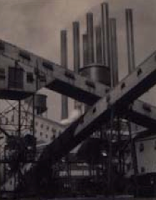CITIES & FILMS
- The city in Modernism
- The beginnings of an urban sociology
- The city as public and private space
- The city in Postmodernism
- The relation of the individual to the crowd in the city
Georg
Simmel
(1858- 1918)
- German sociologist
- Writes Metropolis and Mental Life in 1903
- Influences critical theory of the Frankfurt School thinkers eg: Walter Benjamin, Kracauer, Adorno and Horkheimer
Dresden
Exhibition 1903
- Simmel is asked to lecture on the role of intellectual life in the city but instead reverses the idea and writes about the effect of the city on the individual (Herbert Bayer Lonely Metropolitan 1932)
Lewis Hine 1932
Details from Guaranty Building
Fire cleared buildings in Chicago in 1871 and made way for Louis Sullivan new aspirational buildings
Fordism : Mechanised labour relations - The production line is designed and setup for this repetitive movement
Charlie Chaplin: Modern times 1936
'In handicrafts and manufacture, the workman makes use of a tool, in the factory, the machine makes use of him' (Marx cited in Adamson 2010 p75)
Stock Market crash 1929 - Leads to the great depression
- The resistance of the individual to being levelled, swallowed up in the social-technological mechanism.
- Georg Simmel The Metropolis and Mental Life 1903
- No health and safety - vunrebility
- Creator of the modern skyscraper
- An influential architect and critic of the chicago school
- Mentor to frank lloyd wright
- Form follows function comes from that article
Details from Guaranty Building
- Mechanics of the building are unseen
Carson Pirie Scott Store in Chicago 1904
- Skyscrapers represent the upwardly mobile city of business opportunity
- The american dream rising up to the sky - power , strength of the commercial and industrial environment.
- Fire cleared buildings in Chicago in 1871 and made way for Louis Sullivan new aspirational buildings
Fire cleared buildings in Chicago in 1871 and made way for Louis Sullivan new aspirational buildings
Charlie Chaplin: Modern times 1936
'In handicrafts and manufacture, the workman makes use of a tool, in the factory, the machine makes use of him' (Marx cited in Adamson 2010 p75)
Stock Market crash 1929 - Leads to the great depression
- Factories Close and unemployment goes up dramatically
- Leads to 'The Great depression"
- Maragret bourke - white
Flaner - He is an observer he records what he sees wether its art or literature
Charles Baudelaire - Art should capture - this there observing the crowd
Walter Benjamin -
- Adopts the concept of the urban observer as an analytical tool and as a lifestyle as seen in his writings
- (Arcades Project, 1927–40), Benjamin’s final, incomplete book about Parisian city life in the 19th century
- Berlin Chronicle/Berlin Childhood (memoirs)
Photographer as flaneur -
The photographer is an armed version of the solitary walker reconnoitering, stalking, cruising the urban inferno, the voyeuristic stroller who discovers the city as a landscape of voluptuous extremes. Adept of the joys of watching, connoisseur of empathy, the flâneur finds the world 'picturesque.' (pg. 55)
- Daido Moryama 1970's
- Arbus/Hooper
Gives us the reflection that somethings happened here implication of darkness
Women at counter smoking N.Y.C (1962) Automat (1927)
Venice - City as labyrinth of streets and alleyways in which you can get lost but at the same time will always end up back were you begin.
Don't look now 1973 Nicholas - where ever they go trace of a red cape.
Cindy Sherman Untitled Film Stills 1977-80
- Beautiful but trapped in desire
Film Noir - Weegee (Arthur Felig) - Signature style reporting , His name comes from people thinking he must have a Ouija board always turns up before other press photographers.
Ridley Scoot - Blade Runner 1982 LA
Lorca Di - Corcia Heads - 2001 NY. - He experiments in new york , rome in tokyo . Trip wire system illuminates criminals.
Public Private - In 2006, a New York trial court issued a ruling in a case involving one of his photographs. One of diCorcia's New York random subjects was Ermo Nussenzweig, an Orthodox Jew who objected on religious grounds to diCorcia's publishing in an artistic exhibition a photograph taken of him without his permission. The photo's subject argued that his privacy and religious rights had been violated by both the taking and publishing of the photograph of him. The judge dismissed the lawsuit, finding that the photograph taken of Nussenzweig on a street is art - not commerce - and therefore is protected by the First Ammendement.
Walker Evans Many Are Called 1938 -
Clarke says evans used a concealed camera hidden beneath his trench coat. The result is one of the most incisive series of photographs of city life ever taken. There is a haunting quality appropriate to the environment in which figures are placed. Everyone appears alone and separate.
- Postmodern city in photography: Joel Meyerowitz Broadway and west 46th street NY 1976 - He doesn't tell us what to think . Chaotic overwhelmed with so much information.
- 9'11 Citizen journalism : The end of the flaneur? - Liz wells says that phrase is first seen in an article by stuart allen online news: Journalism and the internet 2006. She discusses the 7/7 bombings in london and the immediacy of the mobile phone images which recorded the event as commuters travel to work. These images were online within an hour of the event.


























No comments:
Post a Comment